














Forest conservation is an essential strategy for addressing climate change.
Your support helps the Forest Society conserve and manage forests for the long term.
To make an additional gift toward forest stewardship for today and tomorrow, please visit forestsociety.org/ stewardshipmatters.
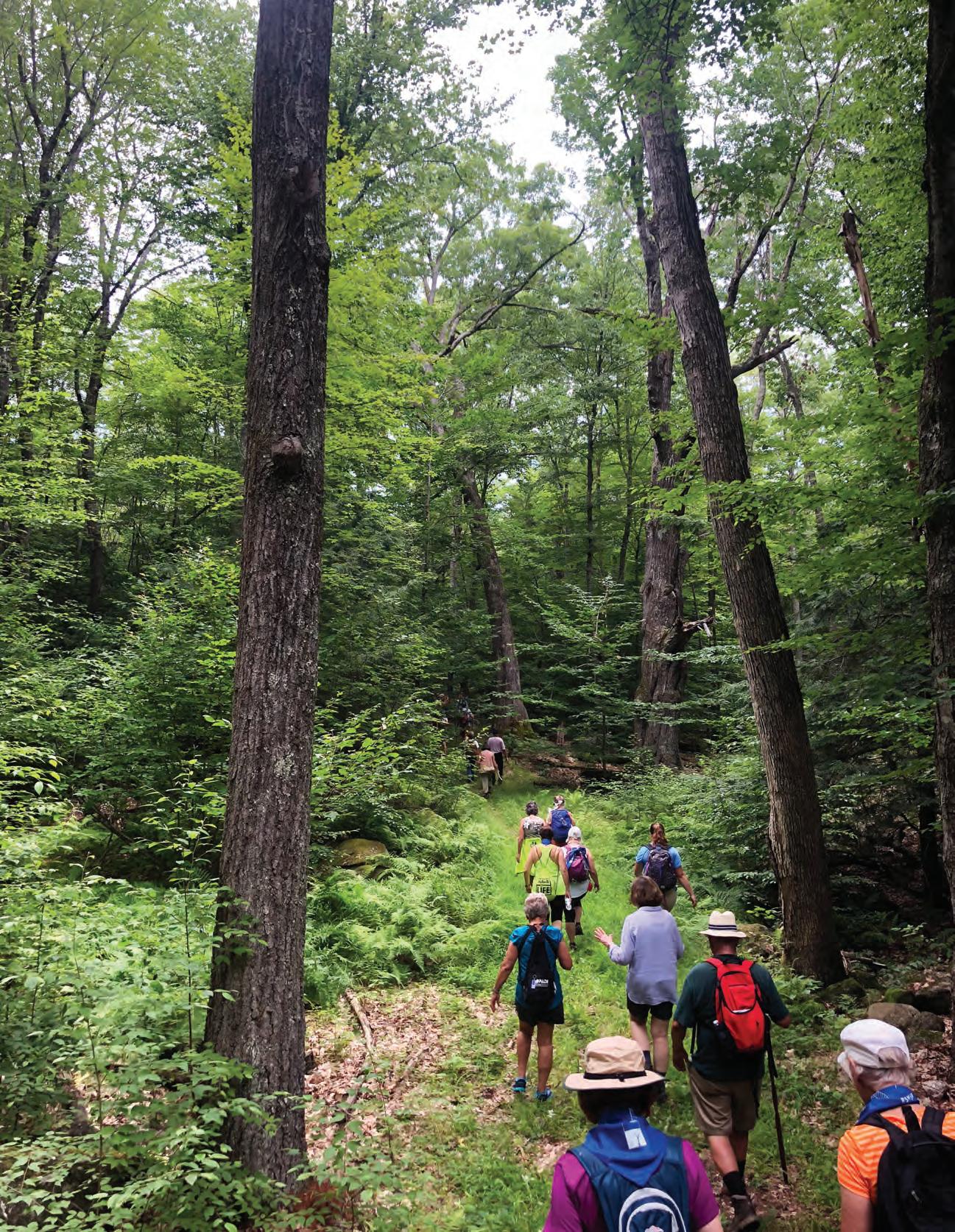
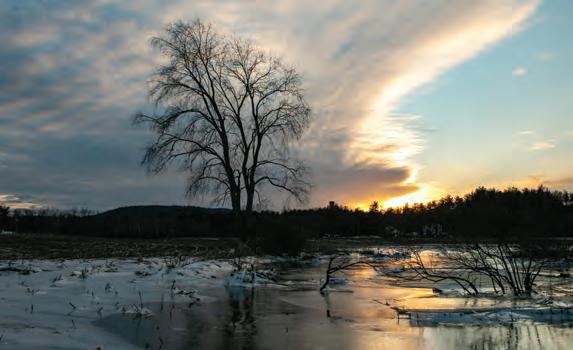
When lakes and ponds freeze over, oppor tunities abound to get out and enjoy ever ything winter has to offer, whether you ’ re on sk ates, sk is, or snowshoes.
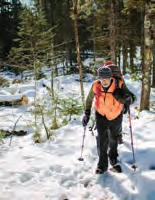
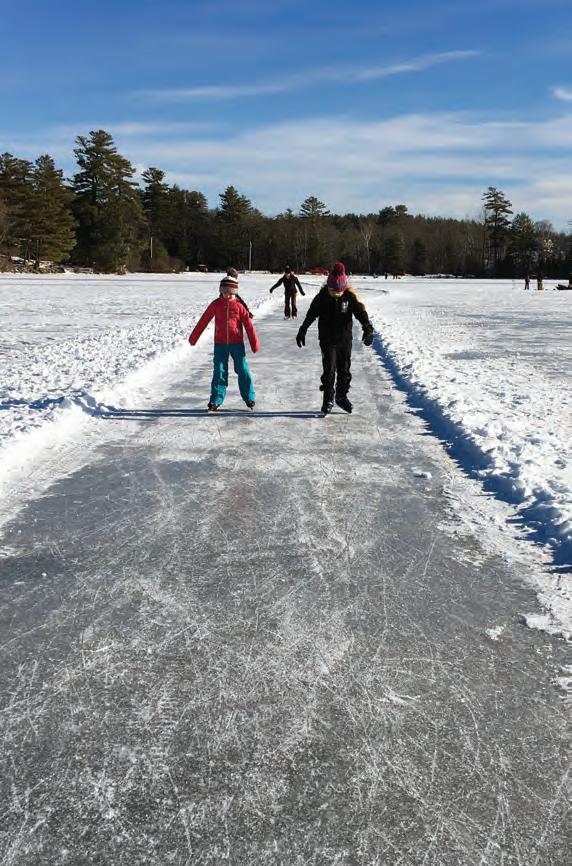
D E PA
2 F R O M T H E P R E S I D E N T ’S D E S K
Managing our forests thoughtfully

4 T H E W O O D P I L E
+ Forestr y education and outreach



+ Welcoming all to the Floodplain
+ Dedicating a trail for Tom
7 I N T H E F I E L D
The return of a spring lecture series
8 CO N S E R VAT I O N S U CC E S S S TO R I E S
+ A conser vation corridor in Alton
+ Grants for the Granite State
11 O N O U R L A N D
+ The Rocks goes green
+ Monson memories
15 N AT U R E’S V I E W
Is this what we call winter?
Affordable energy vs environmental protection
CHAIR
Drew Kellner, Brookline
VICE CHAIR
Bill Crangle, Plymouth
SECRETARY
Allyson Hicks, Concord
TREASURER

Andrew Smith, Twin Mountain
PRESIDENT
Jack Savage, Middleton
BOARD OF TRUSTEES
Philip Bryce, Deering
Deb Buxton, Greenfield
George Epstein, Silver Lake
Elizabeth Salas Evans, Weare
Peter Fauver, North Conway
Don Floyd, Concord
Jason Hicks, Meredith
Patricia Losik, Rye
Nancy Martland, Sugar Hill
Michael Morison, Peterborough
Bill “Tuck” Tucker, Goffstown
Tom Wagner, Campton
Janet Zeller, Concord
STAFF
Will Abbott, Project Manager, The Rocks
Frank Allen, Building and Grounds Assistant
Sarah AlSamaraee, Stewardship & Forestry Administrative Coordinator
Dave Anderson, Senior Director of Education
Brie Belisle, Regional Stewardship Manager
Anna Berry, Director of Communications and Digital Outreach
Nik Berube, Maintenance Assistant
Naomi Brattlof, Director of Easement Stewardship
Rita Carroll, Tree Farm Administrator
Tony Cheek, Vice President for Finance
Connie Colton, Land Protection and Stewardship Coordinator
Linda Dammann, Development Assistant
Carrie Deegan, Reservation Stewardship and Engagement Director
Alex Dow, Christmas Tree Farm Steward, The Rocks
Leah Hart, Land Conservation Project Manager
Stacie Hernandez, Land Conservation Project Manager
Brian Hotz, Vice President for Land Conservation
Steve Junkin, Field Forester
Sarah Kern, Creek Farm Education Program Coordinator
Susanne Kibler-Hacker, Senior Philanthropy Advisor
Allan Krygeris, Senior Technology Specialist
Sara Krzyzaniak, Data Processor
Matt Leahy, Public Policy Director
Cameron Larnerd, Christmas Tree Farm Manager, The Rocks
Margaret Liszka, Membership Director
Nigel Manley, Senior Outreach Manager, The Rocks
Ann McCoy, Development Manager
Jack Minich, Regional Stewardship Manager
Michelle Morse, Human Resource Director
Carl Murphy, Facilities Manager
Meredith Reed O’Donnell, Foundation Relations Manager
Tina Ripley, Administrative Coordinator
Sophie Oehler, Communications Coordinator
Cara Pearson, Membership Specialist
John Plummer, Regional Stewardship Manager
Gabe Roxby, Field Forester
Jack Savage, President
Matt Scaccia, Recreation and Community Relations Manager
Ryan Smith, Communications Manager
Ron Snow, Manager of Individual Giving
Maria Stewart, Senior Executive Assistant
Dylan Summers, Stewardship Projects Manager
Laurel Swope-Brush, Land Steward & Volunteer Programs Coordinator
Anne Truslow, Vice President for Development
Wendy Weisiger, Managing Forester
Harriette Yazzie-Whitcomb, Administrative Assistant
More than 70 percent of New Hampshire’s forests are privately o w n e d . S o m e o f t h e s e l a n d s are permanently protected through conservation easements or, in the case of the nearly 60,000 acres managed by the Forest S o
The balance of forest in the state is publicly owned: 18 percent by the federal government (including 750,000 acres of the White Mountain National Forest and the 25,000-acre Umbagog National Wildlife Refuge) and 10 percent by state and local municipalities. The town you live in may have a designated Town Forest, for example, and the state owns and manages large tracts such as the Nash Stream State Forest, state parks, and state Wildlife Management Areas.
These public lands, situated across the state, have different histories of use and care They encompass a variety of forest types and wildlife habitat, soils, and water resources. While more than half of our forests are northern hardwoods, white pine stands in sandy soils to the south give way to spruce and fir farther north.
Those different forests call for different approaches to management, seeking to achieve multiple goals depending on the resource wildlife diversity; water protection; recreation; resilience to pests; disease and climate change; and sustainably harvested timber.
As we consider how best to address climate change, carbon sequestration and storage are additional positive outcomes
of a well-managed forest. While reducing our emissions from fossil fuels is the most direct way to reduce our collective climate impact, forests play an important role in taking up some of those emissions and storing it in trees, vegetation, and soil. In general, younger forests sequester carbon at a faster rate; older forests store more carbon.
As I’ve written here before, thoughtful timber harvesting can be climate friendly New Hampshire’s forests have benefitted from a century of regeneration, but the resulting even-aged forests are not necessarily diverse and resilient Timber stand improvement is a part of climate-smart management.
And, compared with steel and concrete, wood is a sustainable alternative with a reduced carbon footprint Sustainably harvested wood built into longstanding structures and durable products also stores carbon
As public and private landowners manage ecologically diverse lands across the state whether it’s the White Mountain National Forest or a private family we can achieve multiple benefits and uses, including sustainably harvested wood as well as carbon stored in old growth. They are not mutually exclusive
Jack Savage is the president of the Society for the Protection of New Hampshire Forests He can be reached by email at jsavage @forestsociety.org.

These new staff members are off and running forestsociety.org/newstaff

Rocks Repor t
A vir tual behind-the -scenes tour of The Rocks reno projec t forestsociety.org/restoration-projec t
“On January 1, 2023, I celebrated and photographed the New Year’s Day First Day Hike event held at Monadnock State Park by the Forest Society and New Hampshire State Parks I love the enthusiasm of the day, and I especially enjoy photographing and celebrating with families.”
 – Kate Wilcox
– Kate Wilcox
Tag #forestsociety on Instagram for a chance to be featured in a future issue of Forest Notes.
Society for the Protection of New Hampshire Forests
A nonprofit membership organization founded in 1901 to protect the state’s most important landscapes and promote wise use of its renewable natural resources. Basic annual membership fee is $40 and includes a subscription to Forest Notes.
Editor: Ryan Smith
Design & Production: The Secret Agency
Printing: R C Brayshaw & Company, Inc
Natural Page Turners

Thwar t cabin fever with this curated list of book recommendations



forestsociety.org/sophiesuggests
CO N N E C T W I T H U S!
facebook com/ForestSociety
@ForestSociety
@Forest Society
Forest Notes is printed on elemental chlorine-free Sappi Flo paper with 10 percent post-consumer recycled content Sappi Flo is made from pulp purchased from suppliers who document sound environmental practices and sustainable forest management.
Permission is required for reproduction of any part of this magazine
Copyright 2023 SPNHF US ISSN: 0015 7457
54 Portsmouth Street, Concord, N H 03301 | Phone: 603-224-9945 | Fax: 603-228-0423 info@forestsociety org | forestsociety org

The Forest Society proudly supports the following organizations:


The next time you visit a Forest Society property and you encounter a timber harvest, keep an eye out for one of the newly posted 12” x 18” interpretive harvest signs to learn more about your surroundings. Over the past year, forestry and communications staff designed four signs explaining the type of forestry the Forest Society conducts on its lands and began posting the signs in fall 2022 Support from the Robin Colson Memorial Foundation helped cover costs associated with the printing of the educational signs.
A significant amount of planning goes into implementing a timber harvest, but this work is not always evident to the public. The goal of the signage was to develop a brief, clear design that offers visitors an opportunity to not only see what happened during a harvest, but also understand how the forest will rebound in the years to come.
“We hope these signs can help people recreating on our properties understand the careful thought and science that goes into planning each one of our timber harvests, and encourage them to learn more about
the benefits of sustainable forestry,” Forest Society Forester Gabe Roxbury notes
Before the ground froze, foresters were able to post some of the signs at the Gipson Forest in Greenfield, Heald Tract in Wilton, Crider Forest in Stoddard, Ashuelot River Headwaters Forest in Lempster, and Sanborn Forest in Epping. When the ground thaws in spring, visitors can plan to see more signs in their travels and learn more about forest management in the future.

To make the Merrimack River Outdoor Education & Conservation Area in Concord more welcoming, the Forest Society recently translated its reservation guidance sign at the trailhead into multiple languages. By scanning a QR code sticker adhered to the sign, visitors can access six languages that are common among New American communities in and around East Concord, including Kinyarwanda (language of Rwanda), Nepali, Swahili, Arabic, French, and Spanish “Signage translations that greet visitors in many languages are an important part of making outdoor recreation and the Forest Society’s properties as welcoming as possible to everyone,” says Carrie Deegan, Forest Society reservation
stewardship and engagement director. “Some of our properties, including the Merrimack property in Concord, are within walking distance of flourishing immigrant communities where many languages besides English are spoken,” she notes. “It’s important that we are meeting people where they are without creating any barriers to enjoying the outdoors.”
The Forest Society is in the process of piloting these stickers at reservations throughout New Hampshire and then adding additional languages as determined The project was made possible by donors and sponsors, including the Benjamin Couch Trust, Merrimack County Savings Bank, and Delta Dental
The Forest Society encourages landowners to consult with a licensed forester before under taking land management ac tivities. The following are paid adver tisers.
Calhoun & Cor win Forestr y, LLC
Realize what you value the most in your forest
Ser ving individual, municipal, state, non-government, and industr y forest owners
41 Pine St., Peterborough, NH 03458 • 603-562-5620

Email: swiftcor win@gmail.com
FORECO: Forest Resource Consultants
Complete forest management ser vices
Offering three licensed foresters, licensed land sur veyor P.O. Box 597, Rumney, NH 03266 • 603-786-9544
P O Box 161, Contoocook, NH 03229 • 603-746-4846
Email: office@forecollc com
Full Circle Forestr y, LLC
Ehrhard Frost, NHLPF #103, Thetford Center, V T 802-785-4749 • efrost.fcf@gmail.com
Eric Radlof, NHLPF #447, Antrim, NH 603-321-3482 • eradlof fcf@gmail com
Jeffrey Snitkin, NHLPF #452, Newbur y, NH 802-310-0292 • jsnitkin.fcf@gmail.com
Benjamin Vicere, NHLPF #453, Springfield, V T 802-779-7021 • bvicere.fcf@gmail.com
We specialize in creative, ecological approaches to forest management that are designed to provide long-term economic and intangible benefits to landowners and their forests FCF par tners are licensed foresters, NRCS Technical Ser vice Providers, pesticide applicators, and Tree Farm Inspectors 752 Rt. 103A Newbur y, NH 03255 • 802-310-0292
Mar tin Forestr y Consulting, LLC
Offering complete forest management services, including timber sales, cruises, appraisals, and wildlife habitat management Ask us about recreation trail planning, construction Brontosaurus mowing, and forestr y excavation ser vices

P O Box 89, New Hampton, NH 03256 • 603-744-9484 Email: mar tinforestr y@gmail.com
Meadowsend Consulting Company

Quality Consulting Forestr y with Integrity Guaranteed Jeremy Turner, NHLPF #318 Southern NH jturner@meadowsendco.com
Matthias Nevins, NHLPF #518 Central NH mnevins@meadowsendco com
Ryan Kilborn, NHLPF #442 Nor thern NH rkilborn@meadowsendco com
Vast range of quality land management ser vices. Connect with us for a free site consultation! meadowsendco com • 603 526 8686
Licensed foresters should address inquiries about advertising to Anne Truslow by calling 603-224-9945 or emailing atruslow@forestsociety.org.

With spring on the horizon, anglers are gearing up for another season on the water. Now that the angler access trail at the Forest Society’s Ammonoosuc River Forest is open, they’ll have one more place to potentially land a prized fish this year.

Dedicated to Tom Howe, a beloved long-time employee of the Forest Society who was responsible for the protection of
MA R C H 11, 18, 19, 25, 26; A P R I L 1
Bethlehem
the property prior to his sudden passing in Januar y 2021, the trail was officially opened on July 9, 2022, and the property signage was installed during a dedication with Tom’s family and friends present on October 16, 2022.
The Ammonoosuc River Forest was Tom’s final project, capping a career that conserved more than 35,000 acres across

Tours are ongoing on the days above from 10 a.m.–2 p.m., on the hour Housed in a 1906 building at The Rocks in scenic Bethlehem, The New Hampshire Maple Experience is a hands-on, educational tour Our interactive museum comprises maple artifacts from the extensive collection of legendary sugar maker Charlie Stewart of nearby Sugar Hill.
Tours include a horse-drawn wagon ride to look at the maple lines; a tractor-drawn ride to the sugar house where you’ll meet a fourth-generation sugarer, who will explain the history and science behind syrup; a maple tasting with syrup, donuts, and pickles; and the chance to help tap a tree By the time you leave, you will know how to identify a maple tree, and how to tap and boil the sap The Rocks’ maple syrup will also be available for purchase.
COST: Adults: $20; Children: $18 (or $70 per family, maximum of 2 adults and 2 children), with two rides and tasting included
REGISTER: Reser vations are advised but walk-ins are welcome Email info@therocks org or call 603-444-6228
New Hampshire. Tom was an avid fly-fisherman, outdoor enthusiast, and champion of wild places. He was elated to protect this special forest along the Ammonoosuc R i v e r f o r i t s s p e c t a c u l a r s c e n e r y, r e c r ea t i o n a l v a l u e , w a t e r r e s o u rc e s , a n d high-quality riparian habitat To learn more about the property or plan a trip, visit forestsociety org/ammonoosucriver
MAY 5 6
New Hampshire Farm, Forest & Garden Expo
Deerfield Fairgrounds
The move, new for 2023, will allow the expo to continue its tradition of providing quality educational sessions, promotion o f p r e s e r v a t i o n , a n d o p p o r t u n i t y f o r local commerce in all areas of farming, gardening, and forestry The move also allows the expo to grow in outside spaces where it can incorporate running farm m a c h i n e r y, l o t s o f l i v e a n i m a l s , a n d much more! For more information, visit nhfarmandforestexpo.org.
March 21, March 28, April 4, and April 11
Join the Forest Society and the NH Division of Forests & Lands for the 2023 Cottrell-Baldwin Environmental Lec ture Series at the Henr y I. Baldwin Environmental Center at Fox Forest in Hillsborough.
The event series is free, but registration is requested as space is limited. To register or for more information, call 603-224-9945 ex t. 313 or visit forestsociety.org/events.
Andy has worked for New Hampshire Fish & Game for 28 years and was recently promoted to game programs super visor He has been working as a bear biologist s i n c e 2 0 0 2 , w h i c h h a s a l l o w e d h i m t o e d u c a t e t h e p u b l i c o n b e a r s a n d w o r k toward human-bear coexistence, a topic he finds imperative in wildlife management
T U E S DAY, A P R I L 4 | 7 8:30 P M Ten Years and a Dozen Porcupines: An Informal Study
T U E S DAY, A P R I L 11 | 7 8:30 P.M.
This Land Was Saved for You and Me
T U E S DAY, MA R C H 21 | 7 8:30 P.M.
Covered Bridges of New Hampshire
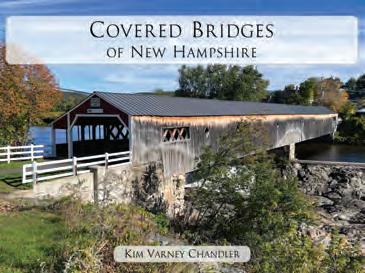
The Forest Society is proud to welcome photographer Kim Varney Chandler to share her research and some interesting facts on covered bridges in the Granite State You will not want to miss this opportunity to learn about our state’s rich and wonderful history
K i m Va r n e y i s a r e s e a rc h e r, a m a t e u r genealogist, photographer, bird watcher, a n d d o g l o v e r W h e n n o t i m m e r s e d i n researching covered bridges, Kim works as a h i g h s c h o o l c o u n s e l o r a n d s p e n d s as much time as she can volunteering for various organizations
T U E S DAY, MA R C H 28 | 7 8:30 P.M.
Black Bears: Understanding and Controlling Human-Bear Conflic ts
Bears, behavior, and conflicts oh my!
Join New Hampshire Fish & Game
Biologist Andy Timmins as he discusses bear population trends, common misconceptions about bear behavior, and the many challenges that black bears face Andy will also discuss the ways in which humans can mitigate conflicts with bears in our communities
Did you know that porcupines have more than 300,000 quills? Or that they are exceptionally good swimmers? At Ann Eldridge’s and Bill Duffy’s presentation, you will learn facts like these and so much more! Ann and Bill will take you on a deep dive into the evolutionar y histor y, anatomy, and habitats of porcupines while offering personal perspectives on the hidden lives and personalities of these amazing creatures This is a fantastic opportunity to learn more about our misunderstood wild neighbors from the people who know them best
Ann received a Bachelor of Fine Arts in printmaking from the Massachusetts College of Art and has been making etchings ever since. She is a member of the Bradford Conser vation Commission, works as a wildlife data collection volunteer, and writes the occasional wandering essay for the Bradford Bridge, a volunteer community newspaper Bill is a cartographer and semi-professional photographer with a master’s degree in geology from the University of Maine
Searching for the next book to read this year? Look no further than Jeffrey Ryan’s This Land Was Saved for You and Me. Newly released, this nonfiction hardcover calls upon names such as Frederick Law Olmsted and Gifford Pinchot to trace the histor y behind their efforts to keep America’s public land “forever wild ” Learn about the many wonderful people working tirelessly behind the scenes to protect and manage natural resources so that they remain accessible for generations to come

Even better, Jeffrey will join us to highlight excerpts from his work and take questions from readers! Bring your copy of this great insight into American natural histor y to get it signed by Jeffrey or buy one at the signing
Jeffrey lives in Maine, where he pursues his passion for exploring both the outdoors and the dusty paths of history His many outdoor adventures have inspired several books, including Appalachian Odyssey: A 28Year Hike on America’s Trail and Blazing Ahead, a history of
t h e A p p a l a c h i a n
Tr a i l ’s c r e a t i o n
When he is not researching or writing, Ryan can be found in h i s v i n t a g e 1 9 8 5
Volkswagen camper
t o u r i n g t h e b a c kroads of America and Canada.
Together with the generosity of two landowners, the Forest Society and local partners recently protected 482 acres of land in Alton, N.H., adjacent to the Forest Society’s 457-acre Evelyn H & Albert D Morse, Sr Preser ve (Morse Preser ve). The conser vation of these two properties enlarges the Morse Preserve and creates a block of 1,250 acres of conserved land at the southern end of the Belknap Mountain Range


The first parcel of land, donated by Dana Freese, expands the Morse Preserve by 222 acres to the south and along the ridge of Pine Mountain. The Forest Society will own and manage the land as part of the Morse Preserve and ensure the protection of its diverse topography and wildlife habitat, including a portion of a large beaver pond and great blue heron rookery, a southwesterly facing cliff and rock ledges with talus slope below, and a black gum-red maple basin swamp “Prior to our family, the Jones family owned this land
for over a century and locals still refer to the land as the Jeramiah and Sam Jones lot,” Dana Freese says “[With its protection], we are happy to know it will be forever managed for its natural values and for the benefit of all ”
The second parcel, donated by the West-Green family, conserves the 260-acre Addison Cate Preser ve, named after the family’s dear friend who gifted them this land upon his passing For decades, Addison Cate dedicated himself to responsibly managing his family land in and around Alton. His efforts were recognized in 1985 when he received the New Hampshire Tree Farmer of the Year Award “Addison Cate was a good man, a great stor yteller, and quite an adventurer, and my family formed a wonderful friendship with him,” says landowner Richard West. “His family had deep roots in the Lakes Region, and while he may be gone, his legacy persists in the land ”
While the West-Green family will continue to own and manage the land, the conser vation easement ensures the protection of a special natural landscape and connectivity with other conservation lands, significant wildlife habitat, responsibly managed forests, and water quality both on the property and downstream “Nothing gives me a greater sense of peace than having a place to retreat to while I connect with the seasons, walk among the trees, and share this with others,” West adds
The Town of Alton Conservation Commission voted to expend funds from their Conservation Fund to support the protection of the conser vation easement on the Addison Cate Preser ve by covering most of the Forest Society’s transaction and long-term stewardship costs.
“The Town of Alton and its Conservation Commission recognize the tremendous value that conser ved land brings to the Town by way of recreation, benefits to
wildlife, scener y, and especially to the protection of water quality,” comments Gene Young, chair of the conser vation commission “The Conservation Commission was especially delighted to contribute to the protection of the Addison Cate Preserve conservation easement because it fits so well into our efforts to conser ve land in the Belknap Range and protect water quality for Lake Winnipesaukee ”
More than 450 members of the surrounding communities and visitors contributed to raise the remaining costs needed to successfully protect these donations now and long into the future



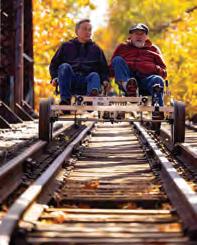

“We were able to connect the Forest Society with the West-Green family years ago, and are thrilled that this land is now protected,” says Russ Wilder, chair of the Belknap Range Conser vation Coalition


(BRCC). “While BRCC does not own land and does not hold conservation easements on land, we do help member organizations conser ve the significant natural resources and recreational opportunities in the Belknap Mountain Range. Protecting nearly 500 acres of land is something to celebrate,” Wilder notes.



“Together with the West-Green family, Mr Freese, BRCC, the Town of Alton Conser vation Commission, and many generous donors, we are excited to help expand the extensive patchwork of climate-resilient conser vation land around the Belknap Mountains, including the Forest Society’s Morse Preserve,” says Jack Savage, president of the Forest Society
“We are immensely grateful that these landowners trust the Forest Society to protect and care for this land ”


Before she died in 2019, Mar y Jane Morse Greenwood, who donated a majority of the 457-acre Morse Preser ve to the Forest Society in 2008, and the remaining land in 2016, said the property is “as close to heaven as one can get without actually being there ” She may have been partial, but on a clear day, a moderate hike to the top of Pine Mountain offers heavenly views as far as Mount Monadnock to the south and Mount Washington to the north With open blueberry barrens at the summit providing excellent berry picking in season coupled with the stunning views, many visitors would agree with Mar y Jane that the Morse Preser ve is heaven on earth

In December 2022, Governor Sununu announced $4.3 million in matching grants to support 34 land conser vation and historic preser vation projects across the state. Provided by the New Hampshire Land and Community Heritage Investment Program (LCHIP), the grants will assist municipalities, nonprofits, and community groups in rehabilitating 17 historic structures and permanently conser ving more than 2,700 acres of farm, timber, and ecologically significant land in all 10 counties across the state “The Forest Society is grateful to receive $307,500 in LCHIP funding to support the Forest Society's land conservation projects in Canterbury, Concord, and Middleton, which will protect water quality and wildlife habitat in these communities,” says Brian Hotz, vice president for land conservation.
Grant recipients are required to match each dollar contributed by LCHIP with a minimum of one additional dollar and to complete the funded projects according to the program’s rigorous standards. The 2022 awards of $4 3 million will be matched by more than $15 million in funding from other public and private sources, infusing a total of more than $19 million into the state’s economy in direct project activity “It’s such a pleasure to…support the efforts of these organizations to preserve our state’s heritage,” said LCHIP board chair Ben Wilcox “The projects the grants support represent the heart of the Granite State They mean the preservation of our history, our culture, and our stories for generations to come.”
The Forest Society projects that received LCHIP funding are:
• Deepwood Forest Conservation Easement, Canterbury: A $180,000 grant will help conserve the 385-acre Deepwood Forest Dotted with pockets of verdant wetlands and more than 30 vernal pools, the property contains some of the highest quality wildlife

habitat in New Hampshire and will be open to the public for recreational use.
• Morrill Dairy Farm Conservation Easement, Concord: The Forest Society has been awarded $72,500 to help purchase an easement on 208 acres of the Morrill Dairy Farm in Concord. The project will conserve 6,300 feet of frontage on the Merrimack River, 156 acres of prime farmland soils, and 162 acres of high-quality wildlife habitat The farm sells milk to Hood Inc., meats at their retail shop and at the Concord Farmers Market, and grows corn, barley, oats, and wheat for local distilling markets and feed
• Coskie Conservation Easement, Middleton: A $55,000 grant will help protect the 82-acre Coskie property in Middleton. This project will help conserve a crucial “donut hole” at the center of the Forest Society's 2,746-acre Moose Mountains Reservation Protection of this property will conserve
important working forest and wildlife habitat, as well as ensure continued access and enjoyment of the property by the public.
“LCHIP is one of the most competitive grant programs in the state,” LCHIP Executive Director Paula Bellemore says. “This year we received 55 applications requesting $7.8 million in grant funding, with only $4 3 million available I am grateful for the 17 conservation and preservation experts who each volunteered over 100 hours reading proposals and crisscrossing the state visiting project sites, and for LCHIP’s Board of Directors who carefully considered each proposal before making the difficult funding decisions.”
Recipients of the 2022 LCHIP grants are expected to complete the funded work within two years.
To learn more about the progress of these ongoing land protection projects, and see our recent conservation accomplishments, visit forestsociety.org/current-projects.
The installation of a new solar array at The Rocks in Bethlehem was recently completed by ReVision Energy, part of the Forest Society’s renovation project to create Forest Society North at The Rocks.

The solar array is made up of 180 photovoltaic solar panels spanning three ground-mounted rows in a field next to the Carriage Barn This 86 4-kilowatt array will produce over 100,000 kWh of clean solar energy each year and will power geothermal heat pumps The project will offset 156,000 pounds of carbon annually, equivalent to removing 15 passenger cars from the road. “The Rocks will be a place where our kids can continue to connect to the land, learn about our changing climate, and most importantly, learn that we have the solutions to make a positive impact on the climate. They will be able to see first-hand how this solar array produces clean energy,” ReVision Energy co-owner Daniel Clapp says. “The Forest Society and ReVision Energy have a clear overlap in values, including passion, learning, and stewardship, so ever yone at ReVision wanted to be part of this exciting project ”
In June 2022, the Forest Society broke ground on the renovation of the 1884 Carriage Barn, which will retain its historic stone and shingle exterior while featuring a brand new program and event space inside. An insulated building envelope will be created on the interior with a geothermal system for heating and cooling and using the solar array to provide electricity and power the heat pumps The facility will also offer an open galler y and gift shop, classrooms, public restrooms, and offices for Forest Society staff who ser ve the North Country. One of the classrooms will be named the Jane A Difley classroom, in honor of Difley’s 23 years of leadership as the Forest Society’s fourth president/ forester.
“As we designed Forest Society North at The Rocks, achieving net-zero emissions was a high priority,” says Jack Savage, Forest Society president. “The Forest Society has always been a leader in energy efficient building practices When we expanded the Conservation Center in Concord by building the French Wing in 2000, it was the first LEED gold certified building in New England The conversion of the Carriage Barn demonstrates our conservation values and helps educate others on net zero building techniques ”
The newly installed solar array is another step in the multi-year transformation at The Rocks after the loss of historic buildings to a 2019 fire. A hillside amphitheater made with the granite foundation stones of the lost buildings now occupies the site of the fire, offering spectacular White Mountain views, including the Pliny, Kilkenny, and Presidential ranges. The amphitheater will be used as an outdoor classroom, event space, and picnic area. The Forest Society has also relocated the Christmas Tree Farm operations at “The Red House” complex to 686 Main Street, separating farm operations from public use areas.
To make a donation to support the Forest Society North project, visit forestsociety.org/ forestsocietynorth
Anna Berry is the director of communications and digital outreach for the Forest Society
Special thanks to the New Hampshire Community Development Finance Authority (CDFA) and the businesses that have supported our Forest Society Nor th at The Rocks Campaign by purchasing CDFA tax credits!
Badger Peabody & Smith Realty
Bassinger Limited PC
Grapppone Management Inc
Lumbard & Kellner LLC
Mascoma Bank
Meredith Village Savings Bank
Merrimack County Savings Bank
Milestone Engineering & Construction
Nathan Wechsler & Company
Nor thway Bank
ReVision Energy
Union Bank
Woodsville Guaranty Savings Bank
It’s a winter day in my hometown Hollis, N H , and the sun has risen in a dull roar of colors, powder pinks and blues that tint the snowbanks purple around the edges It’s the first morning in a while that really feels like Januar y: crisp, clear, and cold enough that my dog Auggie needs his down jacket. We’re headed down Federal Hill, bouncing off potholes like cartoon cars, in the direction of Monson Village
Resting on the town line of Hollis and Milford, Monson Village used to be a colonial settlement. The settlers left suddenly and mysteriously in 1770, leaving their tiny forest town to the wild Today, the property is owned by the Forest Society and the old woods roads have been converted to trails which can be enjoyed by the public and their four-legged friends. My family has visited Monson for as long as I can remember. Today, in the company of fresh fallen snow, Auggie and I will retrace the steps of my childhood, following the same path my family has taken over the years
My walk begins near the top of Federal Hill, in front of the green wrought iron gate that bars the trail from the road. The
metal is coated with a thin layer of ice, evidence of colder temperatures and a healthy amount of precipitation. The pull off on the side of the road is littered with dead leaves and a pair of tire marks Someone has come and gone an early morning visitor
It used to be that this space in front of the gate was the only parking option for the trailhead On weekends, my family’s Honda CRV jostled for space on the cramped shoulder, competing with many other lovers of Monson who wanted to get out and enjoy the woods My parents would get the dogs together while my brother and I hung off of the gate like bear cubs on a tree branch

Now, the parking lot is a big dirt lot cut into the woods. Even with the expanded space, the lot is chock full of cars on the weekends.
As we enter the property, the trail falls away down a sloping hill. Gravel crunches beneath my feet as we make our way on the path Here, the forest arches towards the trail, as if the birch and elm that line the gravel are leaning in to eavesdrop on the conversations of passersby. Even in
winter, the forest is brilliant with color. Dead birch leaves ser ve as stained glass windows, filtering golden light onto the trail and leaving dappled patterns along the rocks The sunrays reach sparkling fingers from between trunks and bare branches, a warm caress in the bitter air
At the bottom of the hill, a sign rises from the ground It announces that the trails we’re walking on are protected by the Forest Society. I’ve spent my entire life walking past this sign without truly acknowledging what it said or what it meant; but here I am, twenty-two years on, now working for the organization that cares for this land.
I suppose life has a funny way of turning back on itself. Like how I played in soccer tournaments during middle and high school at the very university I would one day attend. Or how I spent four months backpacking through Europe, visiting the same villages my parents took me to when I was barely old enough to walk the streets We think time is linear I think it’s like folding a blanket.
Auggie and I emerge into Monson’s fields where the winter sunlight is melting

the snow-covered hills like frosting slipping slowly off a warm cake Many of my early birthdays were held in these fields In early summer, my family would drag my little red wagon down the hill to picnic in the shade of one of the many large red pines that line the grassy knoll Our dogs would lie begging at our feet, and my grandmother would teach me how to braid clover chains, whistle with grass blades and acorn tops, and tickle my grandfather behind the ear with a tuft of foxtail grass

In 2022, I spent the summer surveying Monson visitors in the same fields I picnicked in The Forest Society wanted to learn more about who was visiting, why, and where they were from, among other things. Most people I talked to were locals like me who had been coming here longer than I have for the exact same reasons They told me they loved the fields in summer, the herons that nested in the fall, and bringing their skis to glide down the woods road in winter When I asked them what improvements they thought should be made to the property, they all answered the same: “Just don’t let it change ”
They didn’t want to see things like logging or more people on the trails As a local, I sympathized with them I have watched dozens of trailheads become the most popular spot in town, parking lots filled to the gills with out-of-state plates and occasionally people who don’t respect the land Many forests and fields have been lost to the will of developers, and our favorite trails have been converted into sandpits and cookie cutter backyards. Fortunately, the Forest Society understands the sensitivities of Monson visitors and manages its land responsibly and educates the users who recreate on it
Auggie takes a left through the field, cutting towards the giant boulder that rests in the center in the company of an old oak tree. When I was younger, my brother and I would race to this rock and see who could climb up the steepest face
the fastest. Back then, it was a true challenge It’s funny how large the world seems when you’re 7. At 18, my brother can scale in two steps the same rock he once fell off of face first
I continue past the rock, following Auggie through the gap in the stone wall to the rhododendron grove. Recently, my father discovered a collection of home videos from Christmas-time in 2007 when I was seven years old. One grainy clip is of my cousins and me stumbling through shin-deep snow down this ver y trail, playing hide-and-seek amongst the round bushes that line the path My grandfather’s voice can be heard off camera commending us on our good hiding spots Walking through the leafy plants, I’m reminded of the times when my brother and I would make forts beneath the twisted branches, sheltered by glossy leaves the length of our forearms Inspired by the Boxcar Children and My Side of the Mountain, we imagined we were “lost children” who were running away from home to live in the forest.
Today, as it is every day, Auggie’s destination is the pond. In the summer, he
likes to fetch sticks in the shallows, dodging lily pads and logs that rot underfoot, using his otter tail as a rudder to navigate around clumps of cattails and drowning snags Today, there will be no such frolicking as it is well below swimming temperature even for a well-insulated Labrador Instead, we take in the view of the water and the empty heron nests from the shore In late summer, the snags in the middle of the pond are laden with heron families. You can hear them from halfway down the hill, cavorting like sparrows. They draw quite a crowd My mother’s favorite thing to do on a stuffy August evening is walk down to the water’s edge and count the herons There is always another naturalist already there. They compare numbers. In the fall, the birdwatchers are always saddened by the herons’ departure I know the season has turned a corner when my mother texts me after a walk at Monson to say, “Herons have left,” with more cr ying emojis than would be acceptable for the passing of a family member, let alone the departure of birds. But that chapter, too, will be reopened in the spring. Creatures of habit, the herons
return to the same nests as the year before to allow their fellow habitat-loving species the chance to peer at them through binoculars again
Our trip back to the car takes us past the old Gould House, which is closed for the winter The water bottles the caretaker left out in the summer remain in their box on the stoop, frozen rock solid. The flowers in the beds in front of the blue-grey structure hibernate beneath a blanket of snow and the windowpanes are glazed over, a slumbering giant waiting for spring to bring humanity rushing back.
As we pass the Forest Society welcome sign again on our way out of Monson, I think about all that has changed in the days since I first started coming here to
Monson. I have graduated from high school and watched my brother do the same After graduating from college, I searched for purpose and passion in Europe’s city streets and mountains and came reeling back to America with hands full of both. I have changed in mind and body; so much so that when I look at those old videos of myself tumbling on Monson’s snowbanks, it is hard to believe that I once occupied a body so small, spoke in a voice so high, and lived so simply
The sign of a good friend is that no matter how long you are apart and how much each of you has changed, when you reunite, it seems everything has stayed the same No matter your age, no matter the year, no matter the setting, things just pick
up where they left off. I have a cousin like that My best friend from primary school is like that. Monson is like that. Though I have changed so much since my first birthday in the grassy fields, each time I return feels just like the last.
I am grateful for Monson I am grateful that in these years of never-ending upheaval and transition, there is a place I can go where change is not so prevalent Where I can step into the woods and be seven years old once more, running through the trees, leaving the outside world locked in the car. Time stands still. The blanket folds back uninterrupted

Perhaps you’ve just come inside from shoveling, snow blowing, or sledding? I hope so because until late Januar y, most of New Hampshire still awaited a significant first snowfall Remember? Daily high temperatures remained in the 30s and even 40s during December and Januar y Temperatures spiked into the 60s in November! Regression to average should finally deliver the heavy snow we expect As the temperatures yo-yo, it leaves me thinking about our forests and wildlife and how they might respond to this weather that’s far from normal
Erratic winter temperature fluctuations impact precipitation and snowpack. Meteorologists coined the term “winter weather whiplash” for the succession of low pressure accompanied by warming temperatures, wind, and rain with marginally frozen precipitation. Rain events are followed by high pressure, colder temperatures, and a hard re-freeze, which create an ice-encrusted snowpack. It’s a whiplash effect that leaves humans and wildlife reeling
Beyond impacts to winter recreation and economic tourism, changing weather patterns can affect trees and wildlife best adapted to cold temperatures and deep snow

In response to shorter day length in autumn, hormonal changes cause snowshoe hares and short-tailed weasels to turn white in winter to better blend into a snowy forest floor. Without snow, these northern species are more visible and more vulnerable to predators.
A deep snowpack provides thermal insulation and concealment for subnivian
wildlife, including mice, voles, shrews, and red squirrels, which inhabit underthe-snow burrows linked by a maze of tunnels Bobcats, coyotes, foxes, and owls hunt these animals. Extremely deep snow makes it difficult for some predators to hunt while a low snow year can impact rodent populations Rain on frozen ground will flood rodent burrows drowning mice or driving them indoors. Freeze-thaw cycles form an impenetrable crust on top of the snow, and barred owls are impacted when this crust prevents them from reaching rodents beneath the top layer Foxes and coyotes may experience similar difficulties
The 2022 seed crop was spare with few acorns, beechnuts, and a meager wild apple crop Rodent populations were low following a mediocre mast crop in ‘21. The scarcity ripples across the oak forest food chain. As rodent populations bottom out,
predators bobcats or Cooper’s hawks turn their attention to backyard mourning doves, turkeys and gray squirrels All things equal, lower predator birthrates should follow this year.
As for 2023 wildlife “winners,” a lack of snow and prolonged cold improves survival for New Hampshire’s overall deer herd as individual deer conserve heat calories and are spared the exertion of wading in deep snow Turkeys travel readily on bare winter ground and porcupines continue to graze frozen grass nightly in Januar y As for our resident predators coyotes, foxes, and bobcats they may find hunting easier and find available mates and dens more readily during their late Februar y and early March breeding seasons
According to University of Massachusetts Wildlife Biologist Jeff Boettner, whitefooted mice population densities can
increase 100 times (from 2 mice to 200 mice per hectare) during winters following heavy acorn crops More mice, more ticks, and fewer spongy moth outbreaks you read that right! This is because during years when there are high densities of mice, these hungr y critters consume all the moth eggs and pupae on trees, particularly when no other foods are available, thus limiting moth reproduction rates. Conversely, fewer mice lowers tick populations and eventually lowers rates of Lyme disease and potentially allows future spongy moth caterpillar eruptions


What’s also interesting is that climaterelated wildlife range expansions may already be underway. Warmer winters are bringing new species of wildlife to the Granite State, including opossum, cardinals, and Carolina wrens. Facultative migrants animals that wander and are found all over their migration route now choose to overwinter in New Hampshire, including bluebirds and robins Wildlife at southern limits of their ranges may shift further north Moose, lynx, snowshoe hare, pine marten, purple finch, and spruce grouse are species adapted to snowy spruce and fir forests of northern New England and comprise a list of potentially departing species





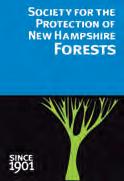
Cold overnight low air temperatures in midwinter limit expansion of forest insect pests, including hemlock wooly adelgid Cold weather is important to forest health. It may be that deep snow is just as important Professors Andrew Reinmann of the City University of New York and Pamela Templer of Boston University are documenting how continued snow cover reduction across the Northeast is causing declines in tree growth and forest carbon storage. At the most basic level, snowpack on the forest floor provides critical insulation for tree roots. Where snow depth is sufficient, soil can remain unfrozen even in temperatures below zero However, Hubbard Brook Experimental Forest researchers documented recent snowpack declines and changes in soil freeze-thaw

cycles This could have harmful effects on delicate feeder roots and soil microbes, from bacteria to insects, which require insulation provided by deep snow
In an article the duo published on Boston University’s website, they found “climate and hydrological models show that the area of forests across the northeastern United States that receives insulating midwinter snowpack could decline by 95 percent by the year 2100 Today, 33,000 square miles of forests across northern New York and New England typically have snowpack for several months in winter By the year 2100, this area could shrink to a patch smaller than 2,000 square miles about one-fifth the size of Vermont.”
A companion study of tree growth at Hubbard Brook suggests that sugar maple is a canar y in the coal mine. Researchers used increment borer cores to assess rates of growth of sugar maple stems of trees grown on control plots versus trees where the snowpack was manually removed from the forest floor. The findings “showed a 40 percent decline in sugar maple growth from plots without snowpack Growth rates remained depressed by 40 to 55 percent over the next three years By contrast, there was no growth decline in the sugar maple trees in reference plots where deep snow covered the trees’ roots in midwinter Sugar maples can account for more than half of the annual forest biomass accumulation at Hubbard Brook. Consequently, changes in climate that reduce winter snowpack and increase soil freezing could reduce forest growth rates in the northern hardwood forest region by 20 percent just through their impacts on these trees ” The results are comparable to other tree root mortality studies at Hubbard Brook where Cornell University researchers Geraldine Tierney and Timothy Fahey reported that an increase of soil freeze events alters fine root dynamics and disrupts nutrient uptake.
Above ground, researchers have noted changes in natural albedo, where the lightcolored high-albedo snow surface reflects more sun back to the atmosphere and lowalbedo surfaces, including dark soil and
tree bark, absorb more sunlight More erratic cycles of thawing dark tree bark and underlying cambium tissues on warm sunny days and subsequent refreezing subject trees to a greater risk of frost cracking when bitter cold temperatures return
events Changes in cold season snowmelt and the amount of winter precipitation falling as rain resulted in transportation of more dissolved and sediment-bound nitrogen and phosphorus that had accumulated in soils
The 2021 N H Climate Assessment Report states that winter average temperatures are expected to increase an additional 10°F and will lead to earlier snowpack melt by the year 2100
Episodes of winter rain runoff from bare frozen ground leads to flooding in small “flashy” watersheds at high landscape positions. Rain on snow is a relatively new phenomenon Historically, winter precipitation arrived gradually and persisted as a long-lasting snowpack gradually released during spring snowmelt in March or April Dormant trees cannot take up and transpire soil moisture back to the atmosphere, and saturated soils freeze and don’t absorb heavy winter water runoff. When meltwater re-freezes in upper soil layers, it creates an impermeable layer of frozen soil, which prevents absorption of water during subsequent rain events and exacerbates future flooding concerns.
Where ice or snowbanks block heavy rain runoff from reaching culverts and drainage features, forest roads, driveways, and local roads are at risk of damage The blocked culverts re-freeze when cold temperatures return
Winter runoff and sediment loads transmit large amounts of dissolved nitrogen and phosphorus formerly bound in soil beneath a stable snowpack. A study led by researchers from the University of Vermont, University of Colorado, University of Kansas, and University of Michigan found climate change poses a significant risk to water resources in New England. The study reported climate change has increased the frequency of rain-on-snow
Climate Central, a nonprofit research organization, released a report that analyzed temperature data from 238 sites across the U.S. to measure how much winters warmed since 1970 At 232 sites (97 percent of those studied), average winter temperatures increased during the past 50 years Two of the top five cities that experienced the largest increase in winter temperatures were in New England: Burlington, Vt (7 1°F), and Concord, N H (6°F).The report showed that winter is the fastest warming season for 75 percent of the locations and warmed more than two degrees Fahrenheit or more in 87 percent of the locations studied
Beyond economic impacts to New Hampshire’s traditional winter tourism economy, largely hidden ecological impacts of erratic fluctuations and warmer temperatures bringing rain are shrinking the traditional five-month winter weather window It’s also true that warm air holds more moisture potentially enabling heavier snow events if it remains cold enough for snow If heavy snow and more consistent cold temperatures return for the second half of winter, appreciating their importance to wildlife and forests makes the weather easier to take.
This winter, outdoor recreation fans and lovers of forests and wildlife grew alarmed by the paltr y snowfall depth at half time. Yet in the third quarter, “team winter” is likely to attempt a comeback. I hope it does
What’s interesting is that climate-related wildlife range expansions may already be under way.

Photos and story by Carrie Deegan

It’s that time of year again: the time when mere mortals can walk on water. Frozen water, sure, but it’s still one of the coolest (pun intended) feats of the season. There is something magical about sliding, skiing, skating, or snowshoeing out onto a frozen pond, exploring islands and coves you’ve reached by boat in the summer, except now you can just walk there like you’re heading to the mailbox. In my family, we wait not-so-patiently for those few perfect smooth ice days when we can slide out some goals and challenge friends to a spirited game of pond hockey Even when there is snow cover, frozen lakes and ponds provide unlimited winter fun. Where else can you cross-country ski or snowshoe for hours, enjoying expansive views without all those exhausting New Hampshire hills? Or pounce on a triggered tip-up and pull a fat perch up through the ice? In recent years, local Nordic skating enthusiasts have been plowing ice skating trails on many of our lakes, revealing miles of beautiful glassy ice for recreation even after all the lakes are snowbound
Opposite page: The author’s hockey skates make tracks on Mascoma Lake in Enfield, N H , last winter
Top: Kids enjoy a Nordic skating trail on Kezar Lake in Sutton, N.H., in 2021. Trails maintained for Nordic skating, where skate blades are attached via bindings to crosscountry ski boots, can also be enjoyed by anyone with hockey or figure skates.

Bottom: Family and friends play pond hockey on Otter Pond in New London, N.H. New Hampshire hosts several pond hockey tournaments, including the New England Pond Hockey Classic, which had to be moved from Lake Winnipesaukee to Lake Waukewan in 2023 due to unsafe ice conditions

Frozen lakes and ponds are truly part of the quintessential winter experience in New Hampshire, but how does it happen? When the air temperature drops in the fall, water at the surface of lakes also cools. Cool water is denser than warm, so the cooled surface water sinks toward the bottom of the lake, exposing warmer water above to the cool air again The process repeats until the entire water column is a uniform density and temperature of 39°F (4°C), the “magic” temperature when water is at its densest. This is a critical point in the seasonal cycle of any lake, as the uniform density allows the entire lake to mix, which is called fall turnover, distributing dissolved oxygen and important nutrients throughout the water column. It’s also a point that must be reached in order for the lake to freeze over Dropping below 39°F, surface water molecules now become less dense, arranging themselves into a lattice-like crystalline structure with a lower density than the liquid water below The resulting ice floats instead of sinking to the bottom!
The fact that frozen water floats instead of sinking is noteworthy because most liquids do not behave this way (bonus activity: try freezing a cube of olive oil and dropping it into a cup of liquid olive oil), but also because this allows aquatic life to persist under lake ice. Life under the ice isn’t easy Ice effectively seals the lake off like a big Tupperware lid, preventing gas exchange with the atmosphere and resulting in a steady decline in dissolved oxygen Light levels also decrease, especially with snow cover, limiting photosynthesis by aquatic plants, which further reduces oxygen, and reducing visibility for those animals that navigate and feed using sight.
Left: Children gather around a tip-up at an ice fishing demonstration day.

Bottom: Water pools on the ice surface of Little Lake Sunapee in New London, N.H., following a rain event in 2022.
Despite the challenges, aquatic animals and plants in our region have evolved to persevere in frozen lakes Plants often die back significantly, but many have thick, starchy roots that store energy for new growth in the spring or develop specialized winter buds (turions) that resist decay and store carbohydrates that allow the plant to clone itself when conditions improve Some aquatic animals endure the winter months by entering a state of dormancy Turtles and frogs bur y themselves in lake bottom sediments, or rest there in a state of torpor. Amazingly, these creatures can absorb dissolved oxygen through their skin, or persist at near-zero blood oxygen levels for months Fish, on the other hand, typically need to move at least slightly in order to pass water over their gills and absorb oxygen Warmer water specialists such as bass and bluegill seek out the calm, slightly warmer water near the bottom and remain quiescent, reducing their movement and metabolism to conser ve energy Others, including chain pickerel and yellow perch, are better adapted to the cold and slightly more active Ice anglers know that these species are easy to tempt into biting a hapless minnow under

the ice Still other fish species are true winter specialists: lake trout and landlocked salmon are undeterred by cold temperatures, even seeking out the coldest water just under the ice since it holds more oxygen
Lake ice may seem an inviolable reality of winter, but we should not take it for granted There is ample evidence our ice cover is getting thinner and shorter in duration because of climate warming. A recent State of NH lake trends report revealed that “ice out” dates (the day that lakes fully thaw in spring) for 31 of our lakes are averaging about 2 weeks earlier than in the 1930s Instead of early May, we now expect ice out (which, incidentally, is the second time of year that oxygen and nutrients can mix freely throughout the water column) to occur in mid-April Even more disturbing, scientists have predicted that as many as 5,600 Northern Hemisphere lakes that now consistently freeze over will cease to do so by the end of this century. Larger and deeper lakes are most vulnerable, since it takes a longer stretch of consistently cold air temperatures to chill the entire water column Thankfully, New Hampshire’s lakes are still freezing, but several in neighboring states (e.g. Lake Sebago in Maine and Lake Champlain in Vermont) now freeze over during fewer than 50 percent of our winters
What will the consequences be if our lakes no longer freeze in winter? Economic and social repercussions we can quantify, with the loss of ice-related recreational opportunities like snow-
mobiling and ice fishing But ecologically, we aren’t entirely sure Aquatic ecosystems have been studied most thoroughly in the warmer months, and much remains unknown about how trophic food webs, water chemistr y, and species diversity will react if our lakes don’t achieve seasonal turnover and freeze over. Some predictions include warmer summer water temperatures leading to more frequent algal blooms, issues with oxygen depletion near lake bottoms if spring and fall turnover do not occur, and loss of those species most highly adapted to cold water. On the bright side, scientific models also predict that we can significantly slow or even maintain ice loss at current levels if we’re able to curb greenhouse gas emissions and maintain colder winter air temperatures.
If you head out on the ice this winter, enjoy the experience, and be safe. New Hampshire Fish & Game has some helpful ice safety tips and best practices at https://www.wildlife.state.nh.us/ outdoor-recreation/ice-safety html While you’re out there, take a few moments to appreciate all the life and sur vival going on beneath that layer of frozen water under your feet Learning about the changes already facing New Hampshire’s lakes is the first step to taking action and supporting policies that will result in a solid future for our lake and pond ice


During its 2023 session, the New Hampshire Legislature will consider legislation, House Bill 609, that aims to revamp the New Hampshire Site Evaluation Committee, the state authority that reviews and approves the siting of energy facilities in our state. Similarly, the United States Congress will likely consider the federal rules covering energy permitting for natural gas pipelines and power transmission projects The backdrop for both of these efforts is the cost of energy
However, the issues they raise go beyond just the challenge of providing affordable energy As we have seen here in New Hampshire and other regions of the country, these siting decisions are highly contentious. Finding consensus support for energy facilities, whether it is a transmission line, a wind farm, or a natural gas pipeline, has historically been nearly impossible to achieve
Therefore, before establishing any new protocols for siting new energy facilities, policy makers should dig deeper into the impacts, benefits, and drawbacks of redoing the laws and rules that determine the outcome of proposed energy projects. Here are some of the questions they need to consider:
1) Given climate change’s impacts, should the process promote renewable and green energy or should it encourage an “all-of-the-above” strategy?
2) Related to that point, should the process foster the production of in-state energy sources? Would the availability of more local energy resources lessen the price fluctuations the country has experienced in the past?
3) Should the regulatory process incentivize the use of already disturbed land to site projects, such as Brownfields properties
(parcels of land that were previously used for industrial purposes and is contaminated by low concentrations of hazardous chemicals) or along transportation corridors?
4) Should siting policies call for the inclusion of energy efficiency steps? After all, energy consumption is what drives the need for energy production.
In order to avoid these costly battles, policy makers should keep in mind one overarching purpose when considering whether to amend the rules and laws for energy projects Actually, the Declaration of Purpose in New Hampshire’s energy siting law RSA 162-H strikes the right tone and should ser ve as a guide It reads, in part, “The legislature recognizes that the
5) How high a priority will any new rules place on avoiding and minimizing impacts to protected conservation lands? Many of these protected areas have conser vation easements because of their significant and unique conser vation or historic values These lands therefore constitute charitable trusts that exist for public benefit Permitting agencies should not establish and follow a process that breaks this public trust.
6) Would speeding up the permitting process in order to advance energy development result in less input and engagement by local communities and groups affected by new projects?
Of course, ever yone needs and uses energy. It is also true that wildly fluctuating energy costs and availability create economic uncertainty
selection of sites for energy facilities may have significant impacts on and benefits to the following: the welfare of the population, private property, the location and growth of industry, the overall economic growth of the state, the environment of the state, historic sites, aesthetics, air and water quality, the use of natural resources, and public health and safety Accordingly, the legislature finds that it is in the public interest to maintain a balance among those potential significant impacts and benefits in decisions about the siting, construction, and operation of energy facilities in New Hampshire ”
hardship Nevertheless, clean air and clean water are also fundamental human needs Those are precisely the kinds of natural services open space provides society.
Unfortunately, projects too often become antagonistic with the decision seemingly boiling down to energy versus community and environmental protection.
Are changes needed in New Hampshire’s siting law or with the federal siting process? Perhaps, as there are always ways to make regulations more efficient. However, the words in RSA 162-H continue to be relevant, even in the face of high energy costs and controversies o v e r s i t i n g d e c i s i o n s . T h e y s h o u l d continue to guide the process here in New Hampshire
Matt Leahy is public policy director for the Forest Society.
Before establishing any new protocols for siting new energy facilities, policy makers should dig deeper into the impacts, benefits, and drawbacks of redoing the laws and rules that determine the outcome of proposed energy projects.
Summit Circle ($5,000 and up)
Altus Engineering
Badger, Peabody & Smith Realty, Inc.
Bernstein, Shur, Sawyer & Nelson, P A
J and M Morse Trucking, LLC
Liberty Mutual Insurance
Merrimack County Savings Bank
Northland Forest Products, Inc
Seaboard International Forest Products, LLC
Summit Wealth Group LLC
Whalen Public & Media Relations, LLC
Trustees’ Circle ($2,500 to $4,999)
Northeast Delta Dental
The Secret Agency, LLC
President ’s Circle ($1,000 to $2,499)
BCM Environmental & Land Law, PLLC
Bensonwood & Unity Homes
Capital City Subaru
Checkmate Payroll Services
Chinburg Properties
Community Toolbox, Inc.
EOS Research Ltd
Garden Life, LLC
GMEC, Inc.
Lumbard & Kellner, LLC
Mallory Portraits
Martin Forestry Consulting, LLC
Milestone Engineering & Construction LLC
New England Private Wealth Advisors, LLC
NH Conservation Real Estate
Ransmeier & Spellman, P.C.
Rockywold-Deephaven Camps, Inc.
SCM Associates, Inc
Steward ($750 to $999)
Devine, Millimet & Branch, PA
Post and Beam Brewery
Par tner ($500 to $749)
Arcomm Communications Corporation
Bangor Savings Bank
Blue Mountain Forest Association
Capitol Craftsman, LLC
Durgin and Crowell Lumber Co., Inc.
Frog Hollow Forestry
Half Moon Enterprises
Harbor Group
Lincoln Financial Group
The Lyme Timber Company LP
Meadowsend Timberlands Limited
Mediation Partners of New England, LLC
The Music Mill
Pine Springs
R.M. Piper, Inc.
Plymouth Soapworks, LLC
Whole Wealth Management, LLC
Colleague ($250 to $499)
Acapella Technologies, LLC
Ambit Engineering, Inc
Ballentine Partners
Blaktop, Inc.
C&S Wholesale Grocers
Dublin Road Tap Room and Eatery
Eastern Mountain Sports
Gideon Asen LLC
Great Brook Veterinary Clinic, LLC
Innovative Natural Resource Solutions, LLC
Kozikowski Properties, LLC
Lenk Orthodontics
Mulligan Forest, LLC
Orr & Reno P A
Robbins Lumber
Samyn d’Elia Architects PA
Tri-State Iron Works, Inc
Twin State Sand & Gravel Co., Inc.
ADP, LLC
Ameresco, Inc.
American Biltrite, Inc
Amgen, Inc
Autodesk, Inc.
Bank of America
Bank of New Hampshire
Bose Corporation
Boston Scientific
Citizens Bank
Cleveland H. Dodge Foundation, Inc.
Dell, Inc.
Erie Insurance
Gartner, Inc.
General Electric
Gilead Sciences, Inc
Google, LLC
Gradient
John Hancock Financial Services, Inc
Liberty Mutual Insurance
Lincoln Financial Group
MassMutual
Microsoft Corporation
Novartis
Oracle Corporation
Pfizer, Inc.
Raytheon Technologies Corporation
Shell Oil Company
Silicon Laboratories, Inc.
Thermo Fisher Scientific, Inc.
The Travelers Companies, Inc
Vertex Pharmaceuticals, Inc.
VMware, Inc.
We are grateful to the many businesses that suppor t the Forest Society with gif ts of less than $250. The Forest Society…Where Conservation and Business Meet
For information about business memberships, sponsorships, or to initiate a gift membership program for your clients or employees, please contact Anne Truslow at (603) 224-9945 or atruslow@forestsociety.org.
When Lillian “Billie” Noel worked with the Forest Society to conser ve 35-acre Creek Farm in Portsmouth in 2000, her vision was to preserve and maintain the property for the use and enjoyment of the entire community. Now, 23 years later, that vision is in full bloom.
Tucked along Sagamore Creek, Creek Farm is part of a chain of conser vation land along Little Harbor Road that includes the Wentworth Coolidge Historic Site, City
of Portsmouth conser vation lands, and Little Harbor Chapel. The Little Harbor Loop Trail traverses all of these ownerships, meandering from mudflats and tidepools to upland forests and back again. It is a favorite destination for bird watchers, kayakers, paddle boarders, dog walkers, and trail runners.
It is also a hive of activity The recently renovated nineteenth century Carey Cottage houses a combination of office space and
a nonprofit incubator Office tenants include the Blue Ocean Society, Conservation Law Foundation, Seacoast Village Project and others, creating a fertile environment for collaboration. Across the lawn, the Forest Society has renovated a smaller outbuilding as the Forest Society Education Center at Creek Farm with classroom and office space. Through a partnership agreement, the Education Center is the land-based campus for The Gundalow Company’s maritime summer camp, which in 2022 hosted

several hundred kids for day camp and after-school programs Last year, Forest Society education programs on wildlife and nature topics attracted more than 400 participants of all ages to the site.
The place is humming in all seasons, and now it is only missing one critical element: public restrooms. While we all appreciate a porta-potty when we really need one, providing a more accessible and pleasant experience is a basic necessity on the site Think about the variety of users in a kayak, a stand-up paddleboard, or a gundalow returning to land after adventures
on Sagamore Creek or those that might be just making a pit stop during a dog walk or bike trek.
The Forest Society is working with Chinburg Properties, which renovated the Carey Cottage, to build year-round, accessible restrooms available to the public during the hours that the Creek Farm Reservation is open (dawn to dusk and during evening programs). The proposed restrooms will be a free-standing structure located next to the education center, so that their use will not interrupt programs in the building and will be open to all users of the property


This building will contain two family-style bathrooms, a utility closet, and a covered area with a bench and a water-bottle fill station
Thanks to support from the Portsmouth Rotar y and leadership donors, we have raised over $150,000 toward the project, and we are seeking to raise the final $75,000 With your help, the facility will be completed by May of this year, in time for summer use in 2023
Please help us improve the visitor experience at Creek Farm by supporting this urgent campaign!
Name:
Address: Telephone: Email:
Enclosed is my tax- deduc tible contribution of $
AT CREEK FARM
VISA MasterCard Number: Exp. date: Security code:
Please mail the completed form to: Society for the Protec tion of New Hampshire Forests 54 Por tsmouth Street, Concord, NH 03301
Or donate online at forestsociety.org/creekfarm-restrooms
For more information, call Anne Truslow at 603-224-9945 or email atruslow@forestsociety org
Town/City : State: Zip: 4102T053/309
54 Por tsmouth Street
Concord, NH 03301-5400
Address Ser vice Requested
“Duringthe pandemic, I would join a group of women, mostly retired teachers, for afternoon driveway parties One day, our hostess showed us an issue of Forest Notes because there was an article about one of our colleagues in it who was a land steward at Gap Mountain Reservation. I thought that was cool! The issue also included an article about the Forest Society’s new Five Hikes Challenge. Even cooler! The group thought participating in the challenge would be a perfect way for us to socialize safely. Together we chose the reservations we most wanted to hike, and we were off, gathering once a week at whichever location we chose. We
Leslie and Bill Blanding with (from lef t) Rumpus and Max Bow, N.H. Members since 1986
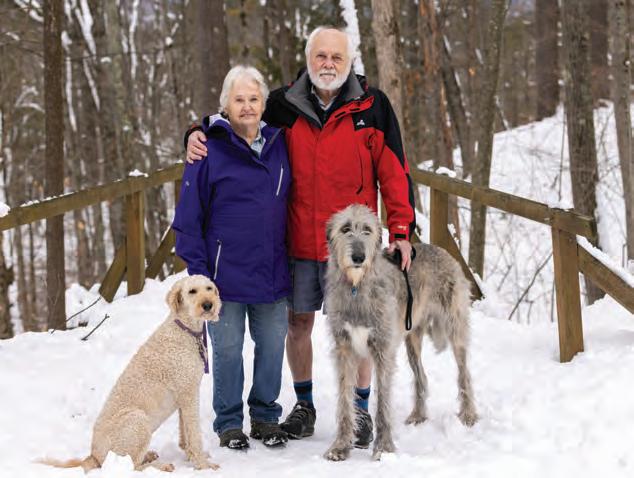
Leslie Blanding is among the 10,000 members who help the Forest Society protect and manage critical lands for wildlife, water quality, wood, and wellness across the state To join her, use the envelope in this issue, or visit forestsociety.org/join-today.
explored places and regions we had never v i s i t e d a n d l e a r n e d a g r e a t d e a l a b o u t history, biology, botany, and geology we never knew Some of our favorite destinations to visit were Monson Center, the Morse Preserve, Madame Sherri Forest, and Creek Farm
“Things got even better for us in fall 2022 when the Forest Society announced their Pop-up Hikes: socialization, exercise, education, and entertainment all bundled into one program! We tagged along for almost every hike.
“Over time, our group has evolved with the addition of friends, husbands, dogs, and other convivial beings. We
occasionally cancelled an outing, particularly in winter when ice can make trails perilous, but generally we come together ever y week for healthy exercise and conversation. Our friendships have strengthened along with our muscles and our appreciation of the natural splendor of New Hampshire. The Forest Society has enriched our lives as well as our environment, helping to preser ve our state’s natural treasures and encouraging us to get out and enjoy them We are proud to be members and supporters.”
Leslie Blanding